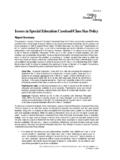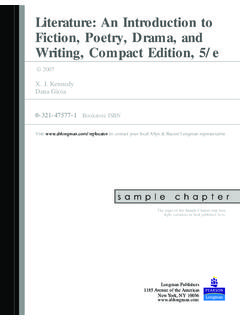Transcription of Marine Corps Base Camp Lejeune chronology of …
1 Marine Corps base Camp Lejeune chronology of significant events concerning contamination of the base drinking water supply . Part 1 1941 through October 1989. Compiled by Mike Partain for use by Introduction This time line was compiled by means of public documents available from the CERCLA and CLW files kept under requirements of Comprehensive Environmental Response, Compensation, and Liability Act (CERCLA) of 1980. There are many documents that still have not been released or are currently being suppressed from public view. As these documents become available, we will update this time line and promptly post it on our website. We are currently working towards completing the second installment of this time line.
2 The research needed to untangle the many documents, errors, hidden information and obfuscation of facts will take some time. We will post the second portion of the time line as soon as it becomes available. 1941 Hadnot Point Fuel Farm Constructed southeast of Holcomb Blvd adjacent to Ash street. The fuel farm was comprised of 15 fuel tanks. There was one 600,000 gallon above ground tank, six underground 12,000 gallon tanks, and eight underground 15,000 gallon tanks. The underground tanks were placed at grade and completely covered with soil. The above ground tank stored diesel fuel while the other tanks stored gasoline, unleaded gasoline and kerosene. The tanks were located in a highly developed area of the base where natural drainage had been modified by extensive areas of asphalt, concrete, ditches and storm sewers.
3 Hadnot Point supply well HP-602 was located 1,200 feet northwest of the Hadnot Point Fuel Farm. Marine Corps records indicate that 20,000 to 33,150 gallons of fuel were lost over the course of the fuel farm s operation. This estimate did not include or account for product lost during transfers or unreported leaks. (Cercla 417). 1950-1952 Installation of Tarawa Terrace (TT) well field and construction of Tarawa Terrace subdivision by Spangler Construction. Three of the initial wells were located along Lejeune Blvd down gradient from established gas stations, automobile repair shops and dry cleaners. These businesses (and residences) were at the time, all on septic ground absorptions systems until city sewers were installed in the1970 s.
4 (Bozarth Interview 1994). 1952- Tarawa Terrace well number TT-26 Constructed. It was located on the base property line along Lejeune Blvd. The well was drilled to a depth of only 95 feet (CLW 3548). Less than a year after construction, ABC Dry Cleaners became operational. The well was now situated less than 900 feet and down gradient from yet another potential contamination source. The well was also down gradient of Glamorama dry cleaners, gasoline stations, and auto repair facilities. In January 1985, this well tested 1580 ppb PCE. (CLW 5011 + CLW 4810). 1953 ABC One Hour Dry Cleaner begins operation at 2127 Lejeune Blvd. The business was located directly across the street from the Tarawa Terrace well fields.
5 According to co-owner Victor Melts, ABC uses 110-165 gallons of Tetrachloroethylene (PCE) per month. The business disposes waste water through an on site septic ground soil absorption system that was located up gradient and directly across the street from the Tarawa Terrace water distribution system s well fields and family housing. The business also generates a solid waste from the PCE reclamation process. This waste was contaminated with PCE and was used as pothole fillers or deposited in the rear of the business from 1953 until 1984. (VJ Melts Depo 04/01). 1953 Possible nerve gas or mustard gas drums were buried near the Rifle Range Chemical dump. According to a 1982 interview with a former civilian employee named Jerry Rochelle, 50-55 drums were buried at the site.
6 Mr. Rochelle noted that the drums were light or bluish green and unmarked. They were protected by rubber matting aboard the trucks and were handled by equipment which had been rubber padded. Mr. Rochelle was required to wear extensive protective gear including a gas mask, hood jacket and gauntlets. He noted that other personnel wore what he called space suits. The drums were buried five feet below the surface side by sides several rows deep. (Cercla 280). 1958 Legrand preliminary and interim ground water report was published for Marine Corps base Camp Lejeune (MCBCL). The report establishes that Camp Lejeune s ground water wells were generally effective up to a depth of 250 feet. Below that depth the water was unsuitable for use.
7 It was noted that the use of shallow wells directly alongside Lejeune Blvd would furnish more than the anticipated water supply for Tarawa Terrace. The disadvantage of these wells was that they would require frequent maintenance inspections and repairs. Furthermore, in 1983, the Initial Assessment study for Camp Lejeune stated the soil was composed of fine sand and was extremely permeable with little or no confining layers that would prevent surface generated contaminants from reaching the aquifer. (CLW 1, CLW 32, CLW 4819-20 & Cercla 1998). 1959 Ed Carper Assumes Administrative control of Camp Lejeune s Chemical Dump. The dump was established in the early to mid 1950 s and used as a dump for hazardous materials.
8 The dump was located near the rifle range. Mr. Carper ran the dump until 1965, when Mr. Don Tallman assumed control. Mr. Tallman administered the dump until 1976 when it was closed. Materials disposed of in the dump included but were not limited to TCE and other PPP chemicals. Mr. Tallman noted in his 1982 statement that base order was expanded in 1974 to include the Air Station. Earlier versions of the order including the order which created the chemical dump and why it was used are now missing. base Order did clearly establish that hazardous substances such as organic solvents were hazardous and the chemical dump was the designated place for their disposal. (Cercla 226). June 1959 Legrand Survey and Evaluation of water supply wells at Camp Lejeune .
9 The report states development of the water wells at Lejeune has reached the stage in which continuous technical assistance in ground water hydrology would be worthwhile. A concern was expressed about increased withdrawal of groundwater (including intra-aquifer movement), especially at Hadnot Point, will increase salt-water encroachment. In 1986, MCBCL consulted with the United States Geological Service (USGS) for a survey of the groundwater at the base to assist in planning, development and protection of the groundwater supply aboard the base . (CLW 102). The USGS found that there was a very dependable source of water aboard the base . However, the aquifer was not well protected from potential surface contamination because clay layers above the water supply aquifer that might serve as a barrier to contamination are thin and discontinuous.
10 The survey also found that with some relatively inexpensive modifications in the design and positioning of future supply wells could significantly improve well yields and reduce costs. (Cercla 1998). December 1959 Department of the Navy Bureau of Medicine and Surgery (BUMED) issued instruction ; Standards for potable water. This instruction applied to all Naval vessels and shore installations which included United States Marine Corps (USMC) installations. The standard defined Health Hazard to mean any faulty operating condition including any device or water treatment practice, which when introduced into the water supply system creates or may a create a danger to the well being of the consumer. (BUMED ).








